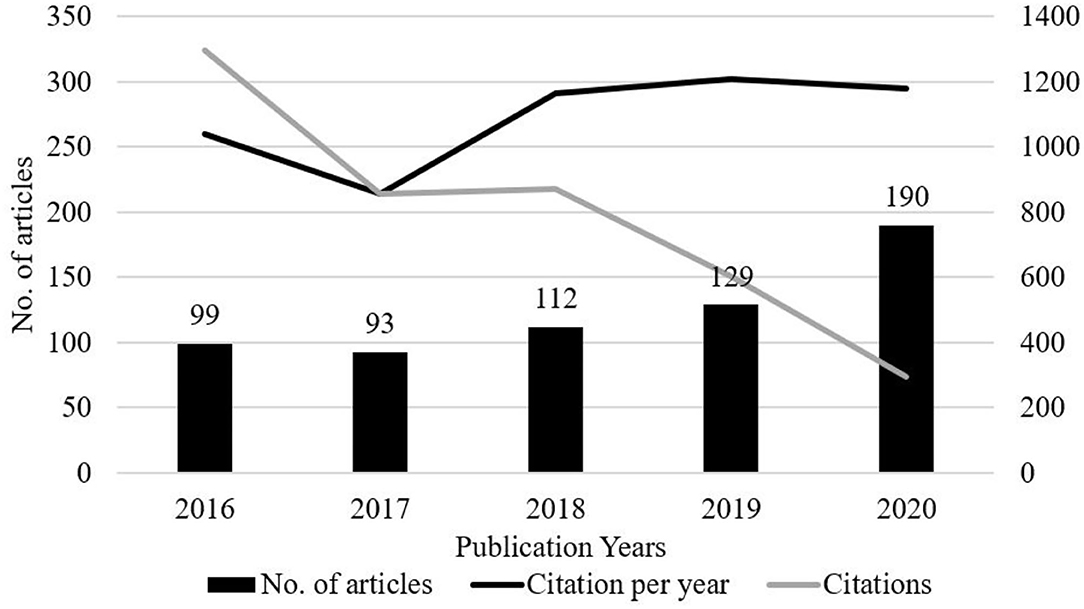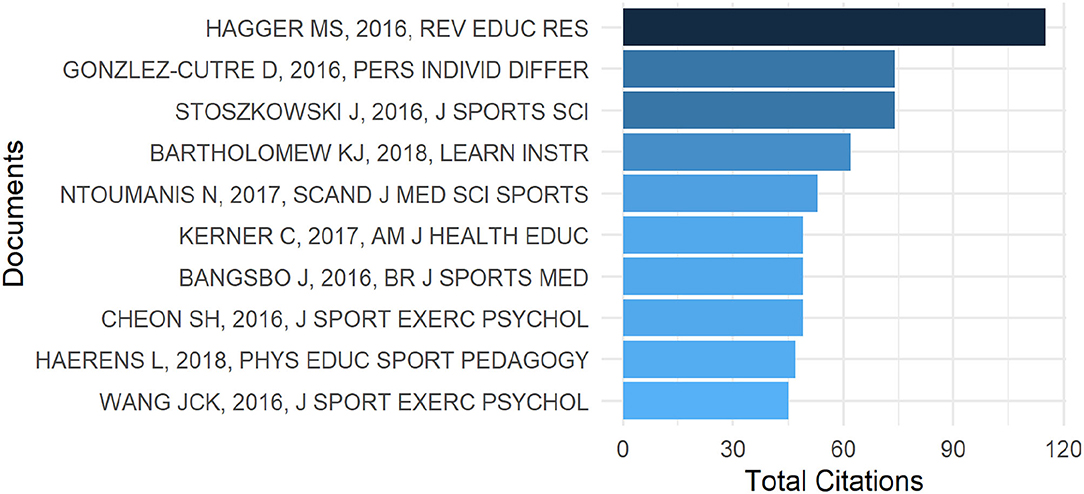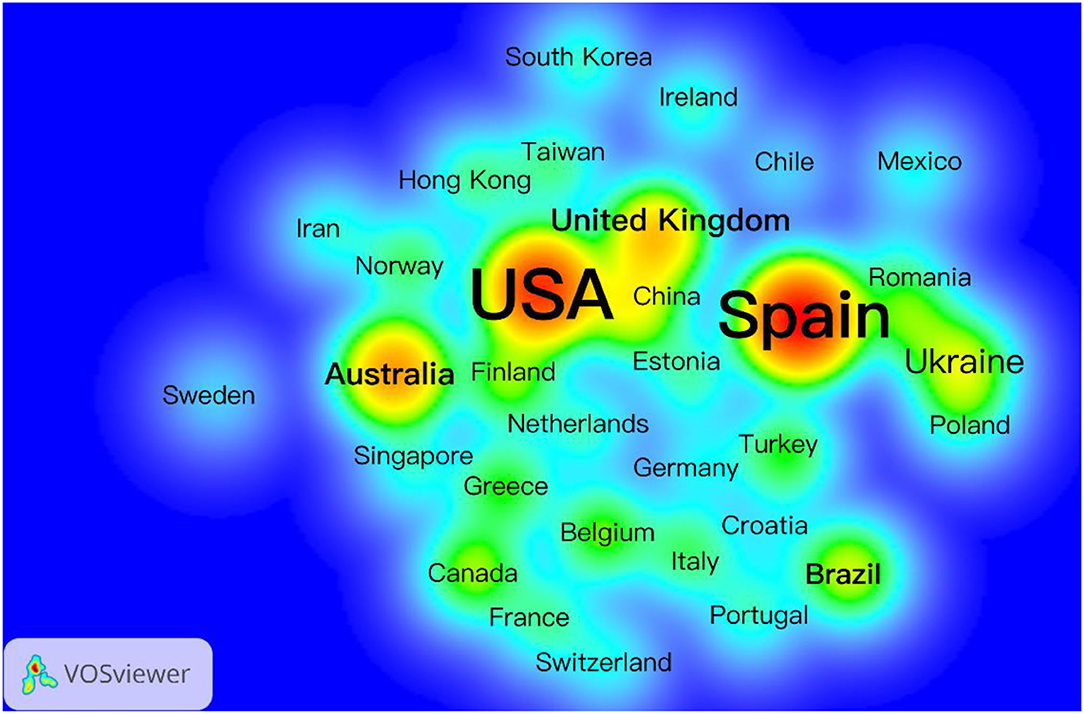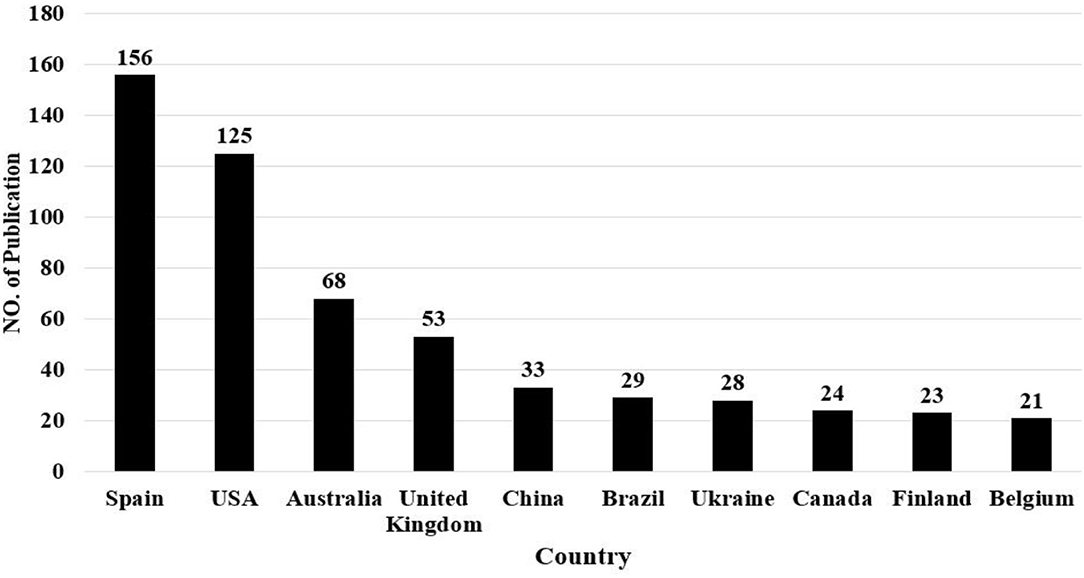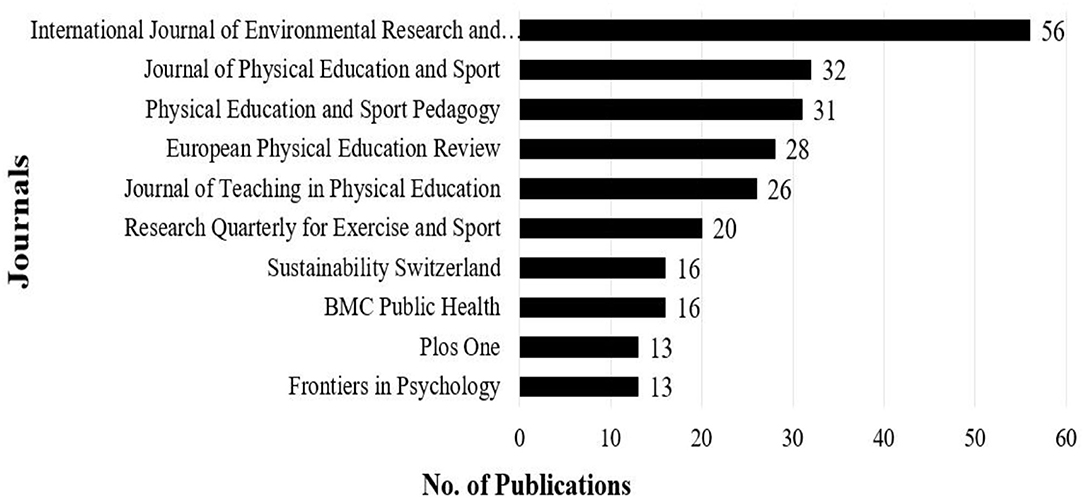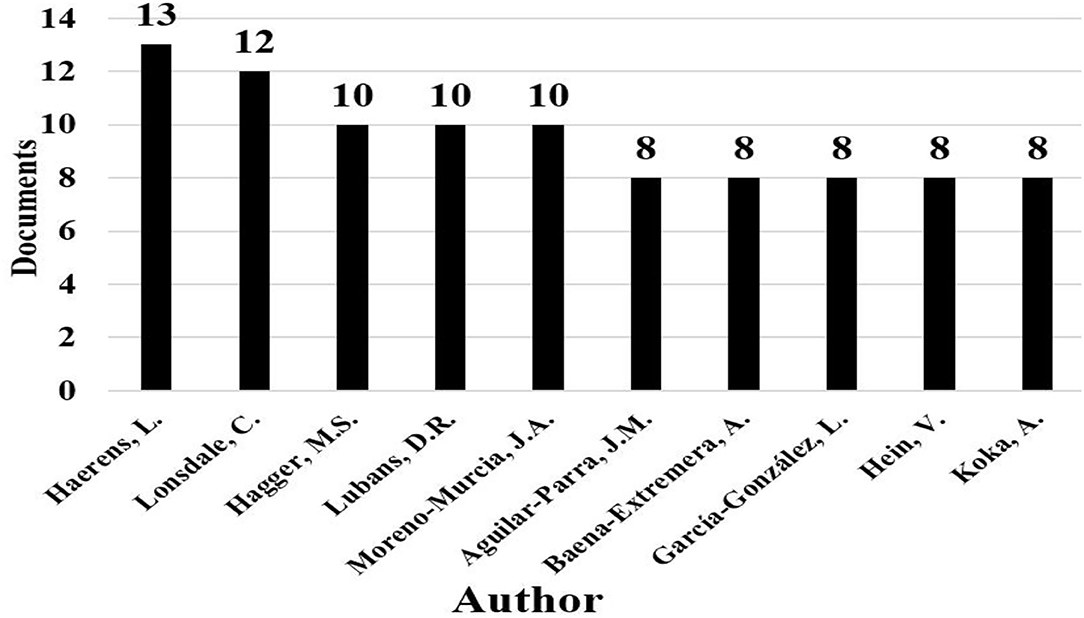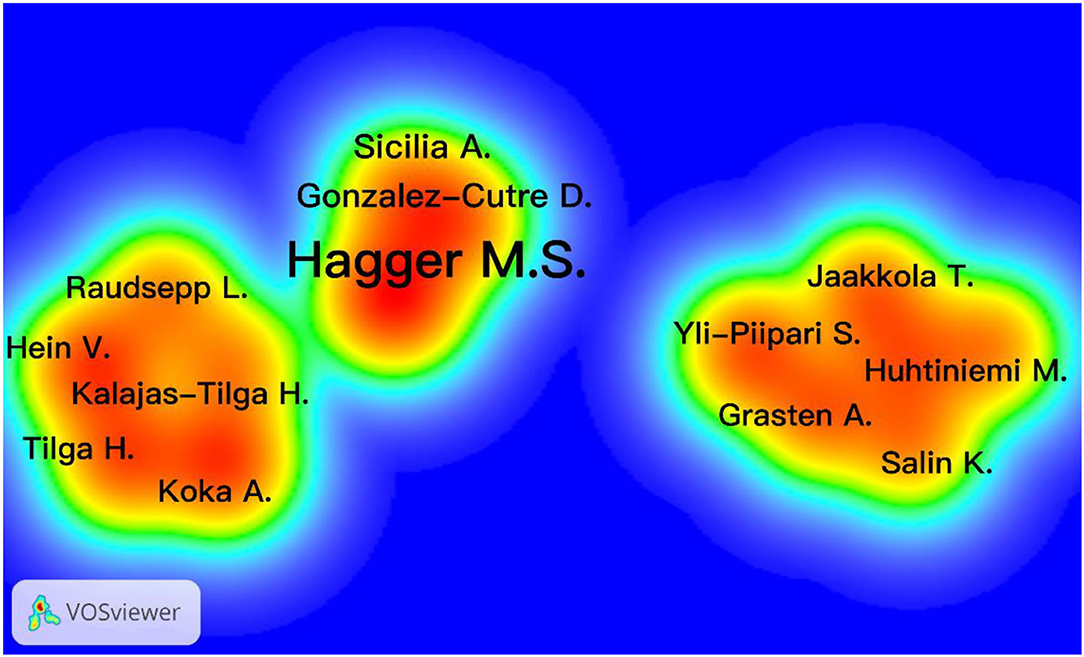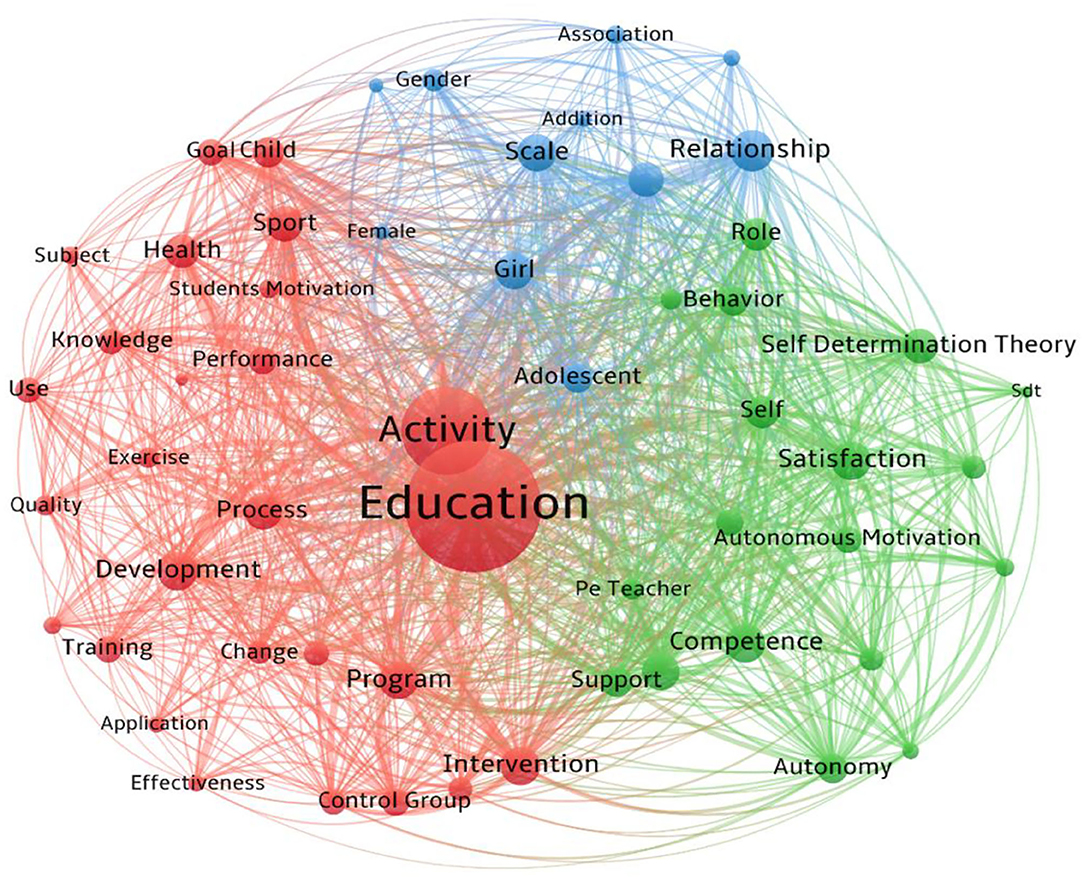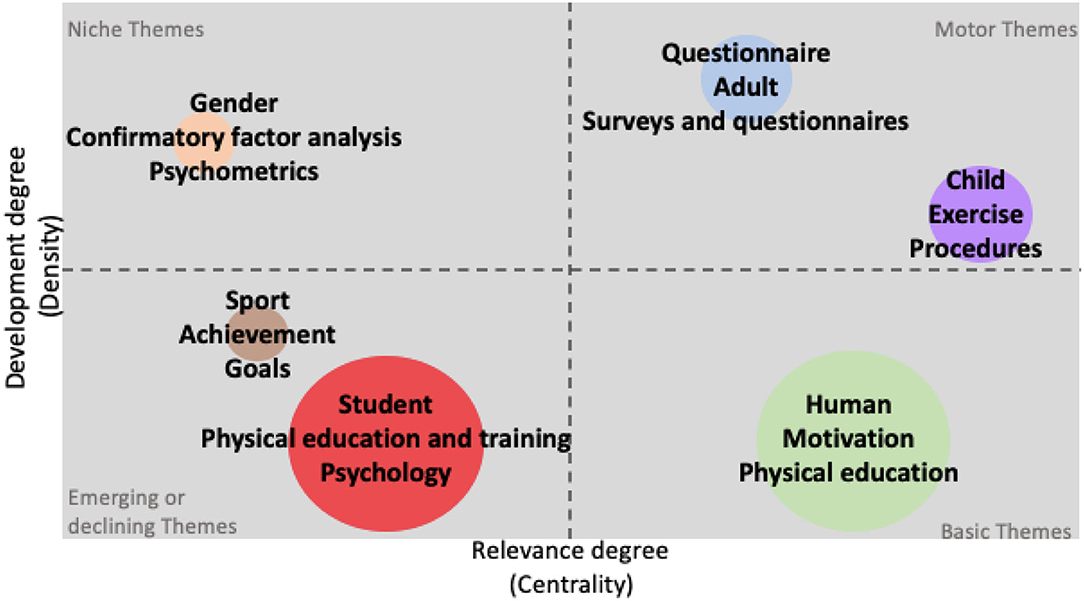- 1Chung Cheng Armed Forces Preparatory School, Kaohsiung, Taiwan
- 2Department of Ball Sports, University of Taipei, Taipei, Taiwan
- 3Department of Physical Education and Sport Sciences, National Taiwan Normal University, Taipei, Taiwan
- 4Department of Education, National Taichung University of Education, Taichung, Taiwan
Purpose: In the field of physical education (PE), which encompasses a wide range of variables, the question of motivation has become increasingly important. The bibliometric methods can help researchers and educators understand the related research of motivation. The purpose of this study was to explore the bibliometric characteristics of motivation in the field of PE from 2016 to 2020 that try to discover the related research context and topics.
Methods: By using the keywords “motivation” and “physical education,” the bibliographic records and references have been retrieved from the Scopus databases (date of search: September 7, 2021). The Vosviewer software tool and Bibliometrix R package were used for information analysis and visualization. The themes include the annual publication, countries/regions, journals, authors, co-occurrences, and theme trends. Finally, it is presented with the characteristics of the big picture of bibliometrics.
Results: From the analysis of the above theme, this study showed that there were 623 studies published over the 5 years, with the number gradually increasing in 2017 and peaking in 2020. The number of citations was the highest in 2016. In terms of total publications, Spain, the United States, and Australia are the top three countries/regions. Most of the articles were published in sport pedagogy and public health relevant journals. The four main research directions were identified: Education, activity, health, and self-determination theory.
Conclusion: This study helped us to comprehend the consistent publishing and rapid development of motivation in PE research. Via the bibliometric analysis, we can also incorporate previous research and predicted trends. All these works can help us to understand the basic psychological needs, leadership styles, and teacher support of PE teachers, and the intrinsic and extrinsic motivations of students at different ages. It is suggested that the in-depth study could be conducted on a single variable or emerging issues for future investigation. Researchers can keep tracking and reviewing motivation-related models.
Introduction
Motivation is an innate and autonomous psychological process that relies on internal needs and emotional–cognitive factors. The internal aspect of motivation is a series of processes ranging from no motivation to external motivation to internal motivation (Ryan and Deci, 2002). In motivation theory, self-determination theory, expectancy theory, situational interest, achievement motivation, and other related theoretical models are used to explore the concept of a multi-directional continuum of motivation from the perspective of motivation connotation. In recent years, there has been an increase in the number of topics related to motivation in the field of physical education (PE), and there have been a growing number of studies examining motivation in PE classes from different perspectives (Sun et al., 2017; White et al., 2021).
In this era of rapid publication and publishing, Howard et al. (2020) use meta-analysis to understand the development of motivational research in the field of education over the past 30 years and similarly suggest that the rapid growth of the literature in recent years has led to the analysis of retrospective articles that may be influenced by the sample (journal articles). Therefore, the article concludes by suggesting that future research could include more data to analyze and determine the impact potential in the field. Although academic journals are the main channel of knowledge dissemination, given the rapidity of knowledge renewal, researchers need to review the expertise in the field appropriately and regularly. Therefore, this study examines the status of PE in motivation-related research through the characteristics of Bibliometric, in order to synthesize and predict various topics for the reference of subsequent researchers.
Motivation in PE
Contextually, the ultimate goal of PE as a school subject is to help students develop good motor skills and lead healthy lives. Over the past few decades, many theories have been developed to better understand and explain motivational learning behaviors and processes, and one of the more widely explored and applied models of school sport is the self-determination theory. Ryan and Deci (2020) explained the importance of motivation in PE from a self-determination perspective and showed that the perception of internal and external motivation was positively related to confidence, happiness, and intention to participate in PE.
In addition, the motivation for PE-related research also includes “physical literacy,” which has been a hot topic in the field of PE and public health in recent years. Whitehead (2010) first outlined the concept of physical literacy, which encompasses the ability to move physically, meaning that individuals have the motivation, confidence, physical competence, and knowledge and understanding to apply and integrate purposeful physical activity into their individual lives. Motivation is one of the four domains of physical literacy, and a physically literate individual has a positive attitude toward engaging in physical activity and sustains the habit and responsibility of exercise (Dudley, 2015; Green et al., 2018). Students or children can develop motor skills and become competent in the concept of physical literacy during sports practices to retain motivation and confidence to participate in physical activity (Roetert and MacDonald, 2015).
In addition to different topics, a variety of studies have been developed to examine motivation in sports for different age groups of learners. De Bruijn et al. (2021) examined whether the satisfaction of children's psychological needs (autonomy, relatedness, competence) directly or indirectly predicted basic motor skills (running, jumping, and object control skills) and motor-related skills (skills developed during participation) from the perspective of children. It is important to note that feelings of competence, peer relationships, and teacher relationships can directly or indirectly influence children's physical and motor skill development. The motivation of children to learn in PE involves multiple factors. In recent years, contextual interest has become one of the ways to measure students' motivation for PE class to understand children's and adolescents' motivation and incentives for PE, including challenge, attention demand, instant enjoyment, and exploration intention (Chen et al., 2001, 2012).
For measuring motivation, Burgueño et al. (2019) predicted students' frustration in PE classes through the Basic Psychological Need Frustration Scale (BPNFS-PE) and showed that a high level of satisfaction with the BPNFS-PE contributed to an increase in intrinsic motivation to promote environmental maladaptation. Huescar Hernandez et al. (2020) suggest that teacher-directed supportive behaviors reduce students' fear of failure. At the same time, students can also create an ideal learning atmosphere. In a study of teachers, the scale was used to measure teachers' emotional engagement and behavioral performance in the workplace, including the importance of partner teacher motivation and the impact of psychological support and beliefs on performance and climate (Cheon et al., 2012; Shen et al., 2015).
Owen et al. (2014) suggested in a meta-analysis study that a broader and more comprehensive analysis could be used to generalize a larger sample (journal articles) to capture the development of knowledge in the field if more diverse variables are to be explored in future. From the above research on PE in motivation, it is evident that the literature in this field has been rapidly evolving due to the number of papers that have been written from different perspectives.
Due to the rapid increase in the number of academic publications in recent years, it is difficult for researchers to keep up with the latest academic trends and update their knowledge at the same time (Briner and Denyer, 2012). As a result, this study evaluates the state of PE in motivation-related research using Bibliometric characteristics in order to summarize and predict diverse subjects for future researchers' reference.
Bibliometric Methods
Academic journals are the primary means by which knowledge is transmitted, and “Bibliometrics” is becoming an increasingly important component of research methodology. The use of mathematical and statistical methods in books and other media was originally defined as bibliometric (Abramo and D'Angelo, 2011). Unique variables, co-citation links, relevant topics, co-occurrence, and co-authorship, keywords, publication countries/regions, organizations, and the effect of specific articles, journals, and authors may all be classified and presented using bibliometrics (De Battisti et al., 2015).
Simple methods are used to organize the current data on a group of study objects. More complex techniques can also be used to create, visualize, and explore maps based on network data (Cobo et al., 2015). This type of analysis not only helps researchers analyze the evolution of literature and research models, but also provides productivity metrics as well as research goals and publication preferences (Abramo and D'Angelo, 2011). Furthermore, bibliometric map analysis software such as VOSviewer, a program for building and examining bibliometric maps (Van Eck and Waltman, 2010, 2017), has arisen, which is characterized by a simple and thorough grouping of subjects.
Co-citation analysis, on the contrary, is a variation of normal citation analysis (Zupic and Cater, 2015). It is a pioneer in the field of bibliometrics, defined co-citation as the frequency with which two units (e.g., authors, documents, journals) are cited together (Cobo et al., 2015). Co-citation can also be used to explain hot trends and is commonly used in computer science, information science, and medicine (Chang et al., 2020; Goksu, 2021). In this research, bibliometric visualizing methods have been applied through VOSviewer to visualize further analysis results. It defined co-citation as the frequency with which two units (e.g., authors, documents, and journals) are referenced together. It is a pioneer in the field of bibliometrics. Co-citation is extensively used in computer science, information science, and medicine to explain current events. To visualize the results of this study, bibliometric visualizing approaches were used in combination with VOSviewer.
As we know from the above, there is a wide range of topics and perspectives in the extensive literature on motivation in PE. Ryan and Deci (2020) review the last 20 years of motivation in PE research and also suggest supporting metrics and network analysis techniques to provide subsequent researchers and practitioners with a knowledge structure and experience in the field. Therefore, this study used a bibliometric method to search through the Scopus electronic database to try to grasp the motivational issues and trends related to school PE. For this purpose, the following five questions have been developed for the study:
(1) What is the status of annual publications for 2016–2020?
(2) Which countries/regions are the 10 countries/regions with the most publications?
(3) What are the top 10 journals that published the most motivation for PE research?
(4) Who are the 10 most frequently published authors?
(5) What are the co-occurrences that were explored in motivation at PE research?
Methods
Ethics Statement
This study was a retrospective bibliometric analysis focusing on analyzing the published articles. No clinical trials were conducted in this study. Approval from an institutional review board was not applicable.
Study Design
It is a bibliometric examination of a specific topic based on the Scopus literature databases. Based on the bibliometric methodology literature, Zupic and Cater (2015) offered process guidelines for science mapping analysis using bibliometric methodologies. For the five-step approach for doing science mapping, the authors followed the preferred reporting items including study design, data collection, data analysis, data visualization, and interpretation.
Data Collection
Data related to the present study were retrieved from Scopus on September 7, 2021. Two terms “Motivation” and “Physical Education” were used as the keywords for searching journal articles. Only those publications published in the years ranging from 2016 to 2020 were considered to retrieve related data from the past. In addition, this study only covers the study of motivation in the field of PE, including school PE classes and other related learning activities, and therefore does not include the concept of terms such as exercise or sport. In line with the main purpose of identifying this research, Scopus is selected as the database for the following bibliometric analysis. Initially, 870 articles were obtained by searching the above two keywords. After manual coding, 67 non-empirical studies and 180 journal articles not presented in English were removed. In the end, 623 journal articles were used as the analysis data.
Data Analysis
To begin, bibliographic data for 623 publications were acquired from the Scopus website and saved as.csv (comma-separated values) files. The saved data contained author names, organizations, article titles, keywords, abstracts, and various citation data. A copy of the.csv file with the identical information was also stored in Excel. Second, the data collected from the Scopus database were imported into VOSviewer software and the Bibliometrix R package to draw a network map and visualize it.
Visualization
A bibliographic visualization tool was created by Leiden University's center for science and technology studies (CWTS). The correlation strength of measurement was used to evaluate network visualization, overlay visualization, and density visualization of cluster normalization (Van Eck and Waltman, 2010). The web of science, Scopus, PubMed, and RIS databases are among the file types that can be analyzed. Author relationship, keyword co-occurrence, citation, and literature coupling are examples of analytical types. VOSviewer is a useful tool for mapping scientific information, and it is well-suited to displaying big bibliometric maps. The maps are very simple to understand (Van Eck and Waltman, 2017). When using VOSviewer to process data, the software will examine the items based on their frequency of occurrence or threshold size. The data will be too huge if the threshold is set too low; otherwise, the data will be too sparse. As a result, the author will establish the visualization map size barrier based on readability and literature analysis.
The Bibliometrix R software package is also an important research tool for literature metrics, containing a range of tools for quantitative literature metrics and scientific metrics research. It is written in R, a tool for developing programming languages and ecosystems (https://www.bibliometrix.org/), and is even available to researchers who are new to coding (Aria and Cuccurullo, 2017). R is a pairwise-oriented functional programming language, so it is easier to simplify the analysis and add new functions.
Interpretation
The final step in the study of bibliometrics is to interpret the visualization results, but there are two points that need special attention here. First, bibliometric methodologies are different from previous literature reviews, meta-analyses, or systematic reviews. It is mainly a big-picture approach to interpreting the structure of various types of academic literature, finding interrelationships and influences, and providing new perspectives to improve knowledge in the field. Second, the interpretation of bibliometric methodologies cannot be trusted too much to match past research but must be interpreted objectively. However, it is still possible to reconcile the results of retrospective articles in the field to understand the past and even predict future developments, so special care should be taken at this stage.
Results
Annual Publications
From the number of publications, it can be understood that the research in the field of motivation in PE has been growing rapidly in the last 20 years, and scholars in various fields have been updating and exploring the knowledge in the field. Figure 1 shows the number of articles published and cited on motivation in PE in the last 5 years. Between 2016 and 2020, no <93 articles per year will be published on motivation in PE. Since 2017, the number of articles has been increasing year by year, and the number will be no <100 in 2018, with the highest number of 190 articles published in 2020.
In Figure 2, we can see the top 10 articles on sports motivation cited by other scholars from 2016 to 2020. Martin S. Hagger and Nikos L. D. Chatzisarantis, authors from Curtin University in Australia, published the most-cited article in the Review of Educational Research in 2016. The study is entitled, “The Trans-Contextual Model of Autonomous Motivation in Education: Conceptual and Empirical Issues and Meta-Analysis.” The article focuses on the transfer of motivational forms of the trans-contextual model from the school PE classroom to the out-of-school environment and confirms that the theoretical model can help students develop autonomous motivation. The article has been cited nearly 120 times, which is a significant difference from other articles. The reason is that the authors based on Deci and Ryan (1985) self-determination theory and extended the trans-contextual model, which emphasizes the emerging model of autonomous motivation, and therefore is widely discussed and cited by scholars. It is also worth noting that the top three cited articles were all published in 2016, with the number of citations ranging from 80 to 110, echoing Figure 1, which was cited 315 times in 2016, the most-cited year in the last 5 years.
Publication Countries/Regions
Figure 3 shows the visualization of the density of country publications, showing the distribution of research on PE motivation in 32 countries/regions between 2016 and 2020. Each dot has a layer of color, ranging from blue to green, then from yellow to red, from the outside to the inside, and from low to high density. The more articles are published, the higher the density of the area, the more the color tends to be red.
Figure 4 shows the top 10 countries/regions, among which Spain has the highest number of published articles with 156, followed by the United States with 125, Australia in third, the United Kingdom in fourth, followed by China, Brazil, Ukraine, Canada, Finland, and Belgium. In particular, the top two countries/regions, Spain and the United States, have a total of 281 articles, accounting for 45.1% of the total 623 articles in the last 5 years. The total number of articles is higher than the total number of articles from the other eight countries (279), which shows the importance of Spain and the United States in the study of PE motivation and their leading role in this field. The distribution of the top 10 shows that Europe is the most represented, including Spain, the United Kingdom, Ukraine, Finland, and Belgium, North America includes the United States and Canada, and the rest of South America, Australia, and Asia each have one country/region in the top 10. The rest of the countries/regions in South America, Australia, and Asia have one country/region in the top 10. This shows that the issue of motivation in PE is widely discussed in European countries/regions. In addition, Asian countries/regions, including China, Taiwan, Hong Kong, Korea, and Singapore, are also involved in the research of motives in PE.
Publication Journals
Figure 5 shows that the top journal was the International Journal of Environmental Research and Public Health with 56 articles, exceeding the number of articles published by many journals. Of these 251 articles, 72 are in the area of public health. The reason may be that the World Health Organization has pointed out that physical inactivity is one of the causes of increased mortality in recent years, with an annual mortality rate of up to 6%, making it the fourth most important risk factor for global mortality. The abovementioned statement forms the beginning of the introductory remarks of most of the articles. Matthews et al. (2012) suggest that physical inactivity increases the development of cardiovascular disease and metabolic syndrome, leading to premature death. Therefore, scholars in the field of public health are actively working to understand the motivation of physical activity in various ethnic groups and to develop strategies to increase physical activity in countries/regions to reduce chronic diseases and related mortality factors.
Next, the second to fifth place is sport pedagogy-related journals, with 117 articles, accounting for 46.6% of the total number of articles. The number of articles in the field of sport pedagogy surpassed that of public health (30.3%). From a long-term perspective, sport pedagogy continues to be the leading PE-related study in motivation and is more thoroughly researched in both theory and practice, as can be seen from the high number of cited articles in Figure 2. From another perspective, both sport pedagogy and public health continue to focus on motivation-related issues, which is a positive thing and means that this issue is continuously being advanced.
Publication Authors
Figure 6 shows the top 10 articles published between 2016 and 2020, with Prof. Leen Haerens of Ghent University in the first place, whose research focuses on PE classes, PE teachers, and student motivation, with 13 publications in the last 5 years. Her most-cited article is “Do perceived autonomy-supportive and controlling teaching relate to physical education students' motivational experiences through unique pathways? Distinguishing between the bright and dark side of motivation.” The article explains that controlling teaching (and subsequent experiences of need frustration) does not simply reflect an absence of autonomy support (and subsequent experiences of low need satisfaction). Finally, it was emphasized that effective teacher training in terms of motivational style may involve more than training teachers to become more autonomy supportive toward their students it may also involve raising awareness among teachers about the motivational risks associated with controlling practices.
Next, the second-place winner is Professor Chris Lonsdale from Australian Catholic University. His research focuses on motivation, behavior, education, and physical activity, and he has published a total of 12 studies on motivation in PE in the last 5 years. His most-cited article is “The Behavioral Regulation in Sport Questionnaire (BRSQ): Instrument development and initial validity evidence.” The study develops and tests a new measure of competitive sports participants' intrinsic motivation, extrinsic motivation, and amotivation. And the BRSQ finally has good information in terms of reliability and validity, which also has a stable foundation for subsequent researchers to use.
The third is Martin Hagger, currently a professor at the University of California Merced, and formerly a professor of health psychology at the University of Jyväskylä. His primary focus is on applying social psychological theory to predict, understand, and change health behaviors. His most-cited article is “A meta-analytic review of the theories of reasoned action and planned behavior in physical activity: Predictive validity and the contribution of additional variables.” The study was to examine relations between behavior, intentions, attitudes, subjective norms, perceived behavioral control, self-efficacy, and past behavior across studies using the theories of reasoned action (TRA) and planned behavior (TPB) in a physical activity context. The major relationships of the TRA/TPB were determined to be supported in this quantitative integration of the physical activity literature, and the addition of self-efficacy and past behavior to the model is an essential contribution.
The fourth-place winner is Professor David Lubans, who works at the University of Newcastle, where he is involved in motor skills and physical activity in children and adolescents. His most-cited article associated with motivation is “Self-determined motivation and physical activity in children and adolescents: A systematic review and meta-analysis.” The study was to assess the association between self-determined motivation and physical activity levels in children and adolescents. The result indicated that overall levels of self-determined motivation had weak-to-moderate, positive associations with physical activity. Autonomous forms of motivation had moderate, positive associations with physical activity, whereas controlled forms of introjection and external regulation had weak, negative associations with physical activity.
Fifth place went to Professor Juan Antonio Moreno Murcia at Miguel Hernández University, who has done a lot of research on motivation and PE and has also developed the Spanish PE Motivation Questionnaire. His most-cited article is “Importance of the Self-Determination Theory in physical-sports practice: Foundations and practical implications.” The study was to review the fundamentals, research, measurement instruments, and practical applications of the SDT in physical activity and sport.
The third to fifth places have published 10 articles, while the remaining six to ten places have published eight articles each. Among the top 10, three Spanish scholars (5, 7, and 8), two from Australia (2 and 4), two from the United States (3 and 6), two from Estonia (9 and 10), and one from Belgium (1) are found, with European scholars accounting for the largest number of six. The results echo Figure 4, with a total of 55 publications, indicating that European scholars are relatively more often motivated to publish research related to the field of PE.
In the density visualization in Figure 7, it can be seen that the collaborative relationships can be divided into three clusters. In addition to collaborative writing and publishing, it is also possible to distinguish by country/region. Among the three scholars in the middle cluster, only Dr. González-Cutre is Spanish, while the other two are American, and all three have published with each other for 5 years. The cluster on the left is a collaboration of professors and researchers from the University of Tartu who wrote the article together. The five people in the right cluster are all Finnish, all colleagues from the University of Jyväskylä, and have published together during the past 5 years. The results show that scholars from European and South American countries are more interactive and collaborative and that scholars from the same country write and publish together on topics related to motivation and self-determination theory motivation, physical activity, health, and physical education teachers and students.
Co-Occurrence
This study searched for keywords in motivation and PE, followed by an analysis of co-occurrence. When words appear frequently together in the journal literature, it means that the concepts of these words are closely related. Co-occurrence analysis is a network of interrelationships between topics, reflecting other word concepts that can be linked in this domain. Therefore, co-occurrence analysis provides a more detailed knowledge base than co-citation analysis (Hallinger and Kovačević, 2019).
Figure 8 shows the co-occurrence network visualization, in which there are three colors for different clusters. The larger the dot means more articles list it as a keyword, and the line between words is the connection between themes, which means two themes are related to each other. The larger the correlation, the larger the dot, which means that the topics are related to it. In general, the red cluster occupies a larger area and covers 21 words (education, activity, goal, child, sport, health, goal, theme, knowledge, student motivation, performance, use, exercise, quality, process, development, training, change, program, intervention, control group, application, and effectiveness), which are more thematic issues and belong to the theme of operational variables. Education and activity are the largest themes in the dots and represent the most relevant words in the study of PE in motivation.
The green cluster consisted of nine words (role, self-determination theory, behavior, satisfaction, autonomy motivation, physical education teacher, support, competence, and autonomy), and these words were more associated with self-determined human factors. The last blue part has five main words that belong to the basic demographic variables (gender, female, relationship, adolescent, and scale). It is interesting to note that the background variables do not show the words male or boy, but rather the results are more likely to be significant for females or girls.
Next, we refer to Cobo et al. (2011) who identified a bibliometric approach that evaluates a research field and detects and visualizes its conceptual subdomains (specific topics/themes or general thematic areas) and thematic evolution using both performance analysis and science mapping tools. Using the Bibliometrix R package's functions, a research area can be viewed as a collection of Research Topics, mapped in a two-dimensional strategic diagram (Figure 9), and split into four categories. Centrality represents the strength of the external links to other themes, which is a measure of the importance of the development of a theme in the field. Density represents the strength of the association between keywords within the themes, and the larger the circle the more proportional the relevance to the theme (number of publications, citations, etc.).
(a) Motor themes: Themes in the upper-right quadrant are well-developed and crucial to the structure of a research field. They are known as the specialty's motor themes because of their high centrality and density. (b) Niche themes: Themes in the upper-left quadrant have well-developed internal relationships but minimal exterior linkages, making them of just marginal regional significance. These are highly specialized and ancillary topics. (c) Emerging or declining themes: Themes in the lower-left quadrant are both marginal and underdeveloped. The themes in this quadrant have a low density and centrality, and they frequently reflect fresh or vanishing motifs. (d) Basic and transversal themes: Themes in the lower-right quadrant are important for a Research Topic, although they are still evolving. This quadrant contains both transversal and general themes.
The themes developed in the four quadrants, as shown in Figure 9, provide a clear picture of the focus and future trends of scholarly research on PE motivation over the past 5 years. Among the motor themes, the adult questionnaire and the children's PE program have been well-developed. In the second quadrant on the top left, highly developed and isolated themes are gender, factor analysis, and psychometrics. The third quadrant contains sport, achievement goals, students, psychology, and physical education and training, which have recently been discussed extensively in the field of PE motivation and are relatively new topics. Finally, the fourth quadrant is human, physical education, and motivation. The scope of human motivation to participate in PE is relatively broad. Even so far, there are still many studies worth exploring.
Discussion and Conclusion
Reviewing and examining the 623 articles published in 2016–2020, motivation research is rapidly evolving. Motivation is a popular topic in psychology and has a long history of research contributions. In the field of PE, sports psychologists Deci and Ryan (1985) self-determination theory has had a profound impact on motivation research, and subsequent scholars have begun to use self-determination theory as a basis for exploring other variables. Ryan and Deci (2020) review nearly 20 years of internal and external motivation research to illustrate the rapid maturation of the field, particularly the application of SDT in education with a focus on promoting basic psychological needs satisfaction for students and teachers. The framework of motivation thus provides much of the evidence base for education in the 21st century and has even led to changes in several educational policies.
For school PE, the field of sport pedagogy is the most explored issue related to motivation. The results of Chu and Zhang (2018), who examined the changes in motivation in students' learning through the sports education model, also showed that motivation plays an important role in PE lessons. However, in the past, studies on motivation in P.E. have mostly examined the development of motivation in the P.E. curriculum from the students' perspective. Nowadays, scholars are more interested in the perceptions of physical education teachers to understand the development of students' motivation in physical education lessons through teachers' leadership and teaching styles (White et al., 2021).
Among the journals searched for in this study, sports psychology, educational psychology, and some public health journals were included. However, sport pedagogy was the most popular, and the reason for this may be that most of the studies were focused on physical education courses or PE-related activities, with teachers or students as the test subjects. Interestingly, the study design of Timken et al. (2019) compared single-sex and mixed-sex studies to understand the differences in student participation and ability levels in PE classes. The results indicated that participation was higher in all-female PE classes, and the greatest health benefits were achieved through higher levels of exercise performance. More importantly, a lack of physical activity, regardless of the reason, may lead to future health problems. As a result, adolescent girls have become the primary target group for motivational research in PE classes (Okely et al., 2017). In recent years, the literature on motivation in PE has begun to change, as not only the fields of sport pedagogy and public health but also other related fields have begun to explore the effects of motivation and PE on human health, increasing the number of submissions each year.
From the results of the number of articles in 2016–2020, European countries (Spain, UK, Ukraine, Canada, Finland, Belgium, etc.) are quite concerned about the research related to motivation in PE, followed by the United States. The number of articles from these countries is significantly higher than that of other countries, and one of the reasons for this is the frequent exchange and cooperation among scholars.
Figures 3, 4 are similar to the findings of White et al. (2021) in that Spain, the United States, and Australia have continued to develop new motivation-related issues in recent years, as well as continuing the relationship between motivation and PE in the past. The research team from the Department of Integrated Didactics, Faculty of Education, Psychology and Sports Sciences, Universidad de Huelva, Spain, also emphasized the satisfaction of basic psychological needs and more self-motivated students. Basic psychological needs and more self-determined motivational forms are related to positive behavioral consequences and that will increase the intention to be physically active in PE students (Fernández-Espínola et al., 2020). In addition, Ryan and Deci pioneered an important direction in motivation-related research in the United States, which has had a significant impact and has led to a large output in motivational research in PE in the United States.
As can be seen in the visualization of the words co-occurrence in this study, “Understanding the need for novelty from the perspective of self-determination theory,” published by five authors from the same cluster, González-Cutre et al. (2016), is a classic collaborative study that includes scholars from Spain, the United States, and Australia. The article, based on self-determination theory, explores the satisfaction of novelty needs and examines the validity and reliability of the Novelty Need Satisfaction Scale (NNSS), with 211 citations (as of 2022.03.01), indicating a breakthrough in reference for subsequent researchers. Later, González-Cutre and Sicilia (2019) applied novelty demand satisfaction and motivation to the PE class and identified novelty satisfaction as intrinsic motivation. Finally, three important predictors of vitality, personality flow, and satisfaction with PE were identified. Moreover, in recent years, scholars in this field have continued to focus on the relationship between novelty needs and motivations in PE activities, including the leadership style of PE teachers or innovative teaching (Hernández et al, 2019).
Aibar et al. (2021) also examined the novelty of teaching and learning satisfaction in school physical education programs, and their results also suggest that a supportive environment is currently associated with novelty satisfaction, including the intention of satisfaction to participation in physical activity. There is a positive correlation between satisfaction and the intention to participate in physical activity. This implies that the design of the physical education curriculum affects the psychological motivation of youth to participate in physical activities. This also reflects that the relationship between physical education curriculum design and student interactions should include strategies that support novelty, enthusiasm for teaching, and personal characteristics that can positively contribute to students' motivation to develop autonomy (Timken et al., 2019).
The Organization for Economic Co-operation and Development (OECD) has taken a whole-person education, calling for schools to be more than just a place to pursue academic achievement. Rather, requires a holistic education that Rather, it is a holistic education that promotes the social, emotional, physical, and psychological wellbeing of students. Therefore, it is also recommended that physical education classes should emphasize students as the main learning subjects and try to improve the quality of teaching to promote students' motivation and interest in PE classes and even cultivate the habit of lifelong participation in sports. Based on this, this study found that the word “education” has been the most relevant core word for learning motivation from the co-word in Figure 8. It is also found from the journals in which the articles are published that the field of PE has the highest number of publications. Accordingly, PE or sport pedagogy has a part in exploring the relationship between physical education lessons and students' motivation to learn (Sun et al., 2017).
In addition, support for students' basic psychological needs positively influences motivation, and teacher support can also help students improve their internal motivation, perceptual skills, and self-esteem (Deci et al., 1981). As a result, teachers' pedagogically relevant knowledge is important, and therefore, teacher training has been emphasized in recent years, echoing the results in Figures 8, 9. This result has also led to an increase in related research on teacher self-support. The reason is that whether teachers' teaching strategies and situational atmosphere can meet students' internal needs are the key factors affecting students' self-directed learning motivation. At the same time, recent research on teacher support has focused on student achievement goals and has illustrated the need for teachers to satisfy autonomy, competence, and relatedness in the learning environment. Therefore, the issue of teacher autonomy support has been followed by a meta-analysis of research on self-determination, and finally, the importance and impact of teacher support on students have been further emphasized and clarified (Vasconcellos et al., 2019).
In addition, from the analysis of previous studies and the results of this study, it is evident that self-determination theory has become a widely used model by researchers, mostly using questionnaires and scales as measurement tools (Ryan and Deci, 2017). In other words, the model of self-determination theory has been an important and central Research Topic for motivation and has pioneered and developed directions in the field for nearly 30 years. Among them, Ryan and Deci (2020) indicated that past research findings have demonstrated that good intrinsic motivation predicts positive outcomes across educational levels and cultural contexts and supports the basic psychological need for students to develop autonomy, which helps to enhance learning outcomes.
It is important to note that student motivation and autonomy are often directly related to teacher motivation, which, like student motivation, is also accompanied by autonomy or psychological needs satisfaction. In other words, PE teachers themselves are controlled by school pressures and leadership styles and are even pulled from above (new policy and decision makers) and below (students and parents with multiple personalities) to influence their teaching (Nie et al., 2015; Guay et al., 2016).
Accordingly, this study has obtained the results of the analysis of multiple bibliographic data through bibliometrics and to found that school PE has focused on motivational studies in the past. These include innovations and developments in education, as well as the rise of student-centered teaching and learning, which has led researchers to look back at the factors associated with teachers' motivation to influence student learning. White et al. (2021) suggested that qualitative research can be used to understand teachers' perspectives in future, to further explore what ideas teachers adopt to accept internal and external factors in the teaching field, and to promote students' learning motivation. Therefore, this study also highlights the research in the field of PE in motivation for teachers to better understand its development trends and contexts.
The limitations of this study are 2-fold, and analysis was conducted only on the Scopus with a limited timeframe of 2016–2020 which may limit the generalizability of findings to the category in general. Second, limitations in the Scopus database may have some unidentified issues; however, the findings shared here for the leading contributors were manually verified. In addition, continuous changes and updates may show different publication data to be analyzed depending upon the date of search and timeframe. Metadata from other sources might be beneficial to complement this study and provide comprehensive context on the subject.
Finally, as academics who have published scientific studies based on bibliometric analysis, we would want to emphasize the importance of science mapping. This strategy takes advantage of quantitative approaches' accuracy, and it is often surprising how much “numbers explain a rich story.” This is due, at least in part, to the approach's concentration on “visualizing relations” between different aspects of the literature. Therefore, after the end of the study, we hope that other academics or databases, such as WOS, will continue with this review study, which could be an alternative for future research. The findings of this fast scoping analysis provided valuable insight into the wide range of publications in the PE motivation field that grasp the past and predict the future.
Author Contributions
C-JC and H-YL: conceptualization. H-YL and J-KF: methodology. C-JC and R-JL: writing—original draft preparation. C-JC, H-YL and J-KF: writing—review and editing. All authors have read and approved the final version of the manuscript, and agree with the order of presentation of the authors.
Conflict of Interest
The authors declare that the research was conducted in the absence of any commercial or financial relationships that could be construed as a potential conflict of interest.
Publisher's Note
All claims expressed in this article are solely those of the authors and do not necessarily represent those of their affiliated organizations, or those of the publisher, the editors and the reviewers. Any product that may be evaluated in this article, or claim that may be made by its manufacturer, is not guaranteed or endorsed by the publisher.
References
Abramo, G., and D'Angelo, C. A. (2011). Evaluating research: from informed peer review to bibliometrics. Scientometrics 87, 499–514. doi: 10.1007/s11192-011-0352-7
Aibar, A., Abós, Á., Garcáa-González, L., González-Cutre, D., and Sevil-Serrano, J. (2021). Understanding students' novelty satisfaction in physical education: Associations with need-supportive teaching style and physical activity intention. Eur. Phys. Educ. Rev. 27, 779–797. doi: 10.1177/1356336X21992791
Aria, M., and Cuccurullo, C. (2017). bibliometrix: an R-tool for comprehensive science mapping analysis. J. Informetr. 11, 959–975. doi: 10.1016/j.joi.2017.08.007
Briner, R. B., and Denyer, D. (2012). “Systematic review and evidence synthesis as a practice and scholarship tool,” in Handbook of Evidence-Based Management: Companies, Classrooms and Research, ed D. M. Rousseau (Oxford: Oxford University Press), 112–129. doi: 10.1093/oxfordhb/9780199763986.013.0007
Burgueño, R., Sánchez-Gallardo, I., Macarro-Moreno, J., Lirola, M. J., and Medina-Casaubón, J. (2019). Examining maladaptive functioning in physical education: a psychometric analysis of the psychological need thwarting scale among Spanish secondary students. Percept. Mot. Skills 126, 1158–1177. doi: 10.1177/0031512519868368
Chang, C. Y., Gau, M. L., Tang, K. Y., and Hwang, G. J. (2020). Directions of the 100 most cited nursing student education research: a bibliometric and co-citation network analysis. Nurse Educ. Today 104–645. doi: 10.1016/j.nedt.2020.104645
Chen, A., Darst, P. W., and Pangrazi, R. P. (2001). An examination of situational interest and its sources. Br. J. Educ. Psychol. 71, 383–400. doi: 10.1348/000709901158578
Chen, S., Chen, A., and Zhu, X. (2012). Are K−12 learners motivated in physical education? A meta-analysis. Res. Quart. Exerc. Sport 83, 36–48. doi: 10.1080/02701367.2012.10599823
Cheon, S. H., Reeve, J., and Moon, I. S. (2012). Experimentally based, longitudinally designed, teacher-focused intervention to help physical education teachers be more autonomy supportive toward their students. J. Sport Exerc. Psychol. 34, 365–396. doi: 10.1123/jsep.34.3.365
Chu, T. L., and Zhang, T. (2018). Motivational processes in sport education programs among high school students: a systematic review. Eur. Phys. Educ. Rev. 24, 372–394. doi: 10.1177/1356336X17751231
Cobo, M. J., López-Herrera, A. G., Herrera-Viedma, E., and Herrera, F. (2011). An approach for detecting, quantifying, and visualizing the evolution of a research field: A practical application to the Fuzzy Sets Theory field. J. Inform. 5, 146–166. doi: 10.1016/j.joi.2010.10.002
Cobo, M. J., Martínez, M. A., Gutiérrez-Salcedo, M., Fujita, H., and Herrera-Viedma, E. (2015). 25 years at knowledge-based systems: a bibliometric analysis. Knowl. Based Syst. 80, 3–13. doi: 10.1016/j.knosys.2014.12.035
De Battisti, F., Ferrara, A., and Salini, S. (2015). A decade of research in statistics: a topic model approach. Scientometrics 103, 413–433. doi: 10.1007/s11192-015-1554-1
De Bruijn, A. G., Mombarg, R., and Timmermans, A. C. (2021). The importance of satisfying children's basic psychological needs in primary school physical education for PE-motivation, and its relations with fundamental motor and PE-related skills. Phys. Educ. Sport Pedagogy 1–18. doi: 10.1080/17408989.2021.1906217
Deci, E. L., and Ryan, R. M. (1985). “Cognitive evaluation theory,” in Intrinsic Motivation and Self-Determination in Human Behavior (New York, NY: Springer), 43–85. doi: 10.1007/978-1-4899-2271-7_3
Deci, E. L., Schwartz, A. J., Sheinman, L., and Ryan, R. M. (1981). An instrument to assess adults' orientations toward control versus autonomy with children: reflections on intrinsic motivation and perceived competence. J. Educ. Psychol. 73, 642–650. doi: 10.1037/0022-0663.73.5.642
Dudley, D. A. (2015). A conceptual model of observed physical literacy. Phys. Educ. 72, 236–260. doi: 10.18666/TPE-2015-V72-I5-6020
Fernández-Espínola, C., Almagro, B. J., Tamayo-Fajardo, J. A., and Sáenz-López, P. (2020). Complementing the self-determination theory with the need for novelty: motivation and intention to be physically active in physical education students. Front. Psychol. 11, 1535. doi: 10.3389/fpsyg.2020.01535
Goksu, I. (2021). Bibliometric mapping of mobile learning. Telemat. Inform. 56, 101491. doi: 10.1016/j.tele.2020.101491
González-Cutre, D., and Sicilia, A. (2019). The importance of novelty satisfaction for multiple positive outcomes in physical education. Eur. Phys. Educ. Rev. 25, 859–875. doi: 10.1177/1356336X18783980
González-Cutre, D., Sicilia, Á., Sierra, A. C., Ferriz, R., and Hagger, M. S. (2016). Understanding the need for novelty from the perspective of self-determination theory. Pers. Individ. Dif. 102, 159–169. doi: 10.1016/j.paid.2016.06.036
Green, N. R., Roberts, W. M., Sheehan, D., and Keegan, R. J. (2018). Charting physical literacy journeys within physical education settings. J. Teach. Phys. Educ. 37, 272–279. doi: 10.1123/jtpe.2018-0129
Guay, F., Valois, P., Falardeau, É., and Lessard, V. (2016). Examining the effects of a professional development program on teachers' pedagogical practices and students' motivational resources and achievement in written French. Learn. Individ. Differ. 45, 291–298. doi: 10.1016/j.lindif.2015.11.014
Hallinger, P., and Kovacević, J. (2019). A bibliometric review of research on educational administration: Science mapping the literature, 1960 to 2018. Rev. Educ. Res. 89, 335–369. doi: 10.3102/0034654319830380
Howard, J. L., Chong, J. X., and Bureau, J. S. (2020). The tripartite model of intrinsic motivation in education: a 30-year retrospective and meta-analysis. J. Pers. 88, 1268–1285. doi: 10.1111/jopy.12570
Huescar Hernandez, E., Moreno-Murcia, J. A., and Espín, J. (2020). Teachers' interpersonal styles and fear of failure from the perspective of physical education students. PLoS ONE 15, e0235011. doi: 10.1371/journal.pone.0235011
Matthews, C. E., George, S. M., Moore, S. C., Bowles, H. R., Blair, A., Park, Y., et al. (2012). Amount of time spent in sedentary behaviors and cause-specific mortality in US adults. Am. J. Clin. Nutr. 95, 437–445. doi: 10.3945/ajcn.111.019620
Nie, Y., Chua, B. L., Yeung, A. S., Ryan, R. M., and Chan, W. Y. (2015). The importance of autonomy support and the mediating role of work motivation for well-being: testing self-determination theory in a Chinese work organisation. Int. J. Psychol. 50, 245–255. doi: 10.1002/ijop.12110
Okely, A. D., Lubans, D. R., Morgan, P. J., Cotton, W., Peralta, L., and Miller, J. (2017). Promoting physical activity among adolescent girls: the Girls in Sport group randomized trial. Int. J. Behav. Nutr. Phys. Activity 14, 1–13. doi: 10.1186/s12966-017-0535-6
Owen, K. B., Smith, J., Lubans, D. R., Ng, J. Y., and Lonsdale, C. (2014). Self-determined motivation and physical activity in children and adolescents: a systematic review and meta-analysis. Prev. Med. 67, 270–279. doi: 10.1016/j.ypmed.2014.07.033
Roetert, E. P., and MacDonald, L. C. (2015). Unpacking the physical literacy concept for K-12 physical education: what should we expect the learner to master? J. Sport Health Sci. 4, 108–112. doi: 10.1016/j.jshs.2015.03.002
Ryan, R. M., and Deci, E. L. (2002). “Overview of self-determination theory: An organismic dialectical perspective,” in Handbook of Self-Determination Research, eds E. L. Deci and R. M. Ryan (Rochester, NY: University of Rochester Press), 3–33.
Ryan, R. M., and Deci, E. L. (2017). Self-Determination Theory: Basic Psychological Needs in Motivation, Development, and Wellness. New York, NY: Guilford Publishing. doi: 10.1521/978.14625/28806
Ryan, R. M., and Deci, E. L. (2020). Intrinsic and extrinsic motivation from a self-determination theory perspective: definitions, theory, practices, and future directions. Contemp. Educ. Psychol. 61, 54–67. doi: 10.1016/j.cedpsych.2020.101860
Shen, B., McCaughtry, N., Martin, J., Garn, A., Kulik, N., and Fahlman, M. (2015). The relationship between teacher burnout and student motivation. Br. J. Educ. Psychol. 85, 519–532. doi: 10.1111/bjep.12089
Sun, H., Li, W., and Shen, B. (2017). Learning in physical education: a self-determination theory perspective. J. Teach. Phys. Educ. 36, 277–291. doi: 10.1123/jtpe.2017-0067
Timken, G., McNamee, J., and Coste, S. (2019). ‘It doesn't seem like PE and I love it': adolescent girls' views of a health club physical education approach. Eur. Phys. Educ. Rev. 25, 109–124. doi: 10.1177/1356336X17706382
Van Eck, N. J., and Waltman, L. (2010). Software survey: VOSviewer, a computer program for bibliometric mapping. Scientometrics 84, 523–538. doi: 10.1007/s11192-009-0146-3
Van Eck, N. J., and Waltman, L. (2017). Citation-based clustering of publications using CitNetExplorer and VOSviewer. Scientometrics 111, 1053–1070. doi: 10.1007/s11192-017-2300-7
Vasconcellos, D., Parker, P. D., Hilland, T., Cinelli, R., Owen, K. B., Kapsal, N., et al. (2019). Self-determination theory applied to physical education: a systematic review and meta-analysis. J. Educ. Psychol. 112, 1444–1469. doi: 10.1037/edu0000420
White, R. L., Bennie, A., Vasconcellos, D., Cinelli, R., Hilland, T., Owen, K. B., et al. (2021). Self-determination theory in physical education: A systematic review of qualitative studies. Teach. Educ. 99, 103247. doi: 10.1016/j.tate.2020.103247
Keywords: bibliometrics, quantitative research, self-determination theory, physical education, motivation
Citation: Chen C-J, Lee H-Y, Lin R-J and Farng J-K (2022) A Bibliometric Analysis on Motivation Between 2016 and 2020 of Physical Education in Scopus Database. Front. Educ. 7:900000. doi: 10.3389/feduc.2022.900000
Received: 19 March 2022; Accepted: 10 May 2022;
Published: 09 June 2022.
Edited by:
Alberto Sanmiguel-Rodríguez, Camilo José Cela University, SpainReviewed by:
Peter Kokol, University of Maribor, SloveniaAndy Wai Kan Yeung, University of Hong Kong, China
Ranjit Singh, Pondicherry University, India
Copyright © 2022 Chen, Lee, Lin and Farng. This is an open-access article distributed under the terms of the Creative Commons Attribution License (CC BY). The use, distribution or reproduction in other forums is permitted, provided the original author(s) and the copyright owner(s) are credited and that the original publication in this journal is cited, in accordance with accepted academic practice. No use, distribution or reproduction is permitted which does not comply with these terms.
*Correspondence: Hung-Ying Lee, ODA5MzAwMThhQG50bnUuZWR1LnR3; Jenn-Kuen Farng, ZmFybmc4ODg1MDVAZ21haWwuY29t
 Chi-Jung Chen1
Chi-Jung Chen1 Hung-Ying Lee
Hung-Ying Lee